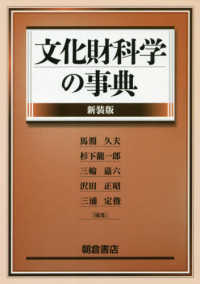- ホーム
- > 洋書
- > ドイツ書
- > Humanities, Arts & Music
- > Arts
- > history of arts
Full Description
Where is Charles Simonds? Throughout the 1970s, his diminutive Dwellings, tiny architectural ruins of an imaginary civilization, could be found throughout the crumbling infrastructure of downtown New York. Preoccupied with the relationship between the grown and the built, the archaeological and the urban, Simonds shared friendship and ideas with Gordon Matta-Clark and Robert Smithson. Like Lucy Lippard, with whom he lived during that decade, Simonds believed in combining art and activism, always preferring what he called the "real world" to the art world. Yet despite taking part in many of the seminal exhibitions and art events of 1970s New York, Simonds has left few traces on art history. In order to explain Simonds's absence while simultaneously arguing for his central place within it, Jules Pelta Feldman reconsiders the decade's self-conception, finding that Simonds exemplifies much of what has been ignored in 1970s art - and much of what establishes it as a unique period of experimentation and possibility.








